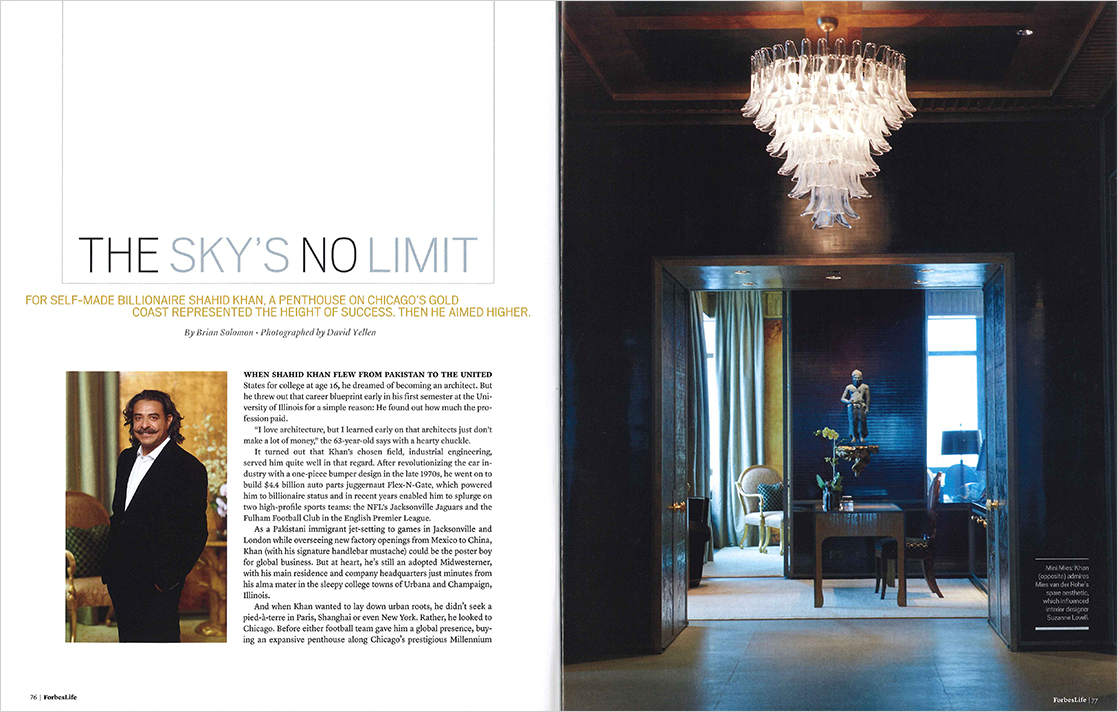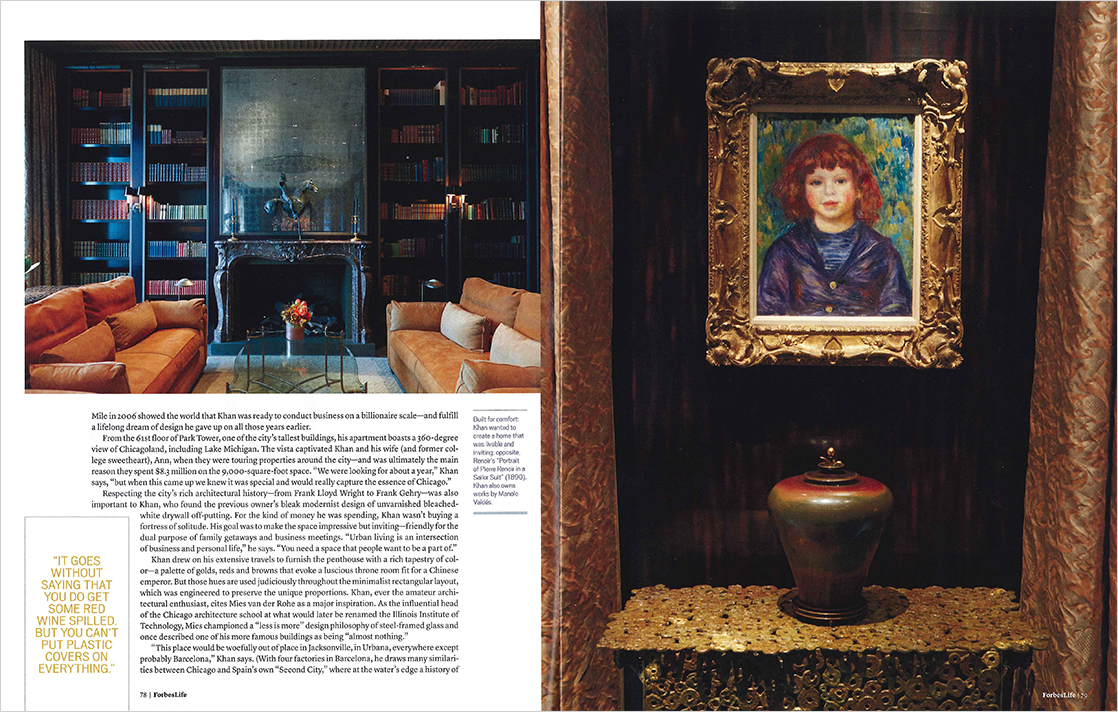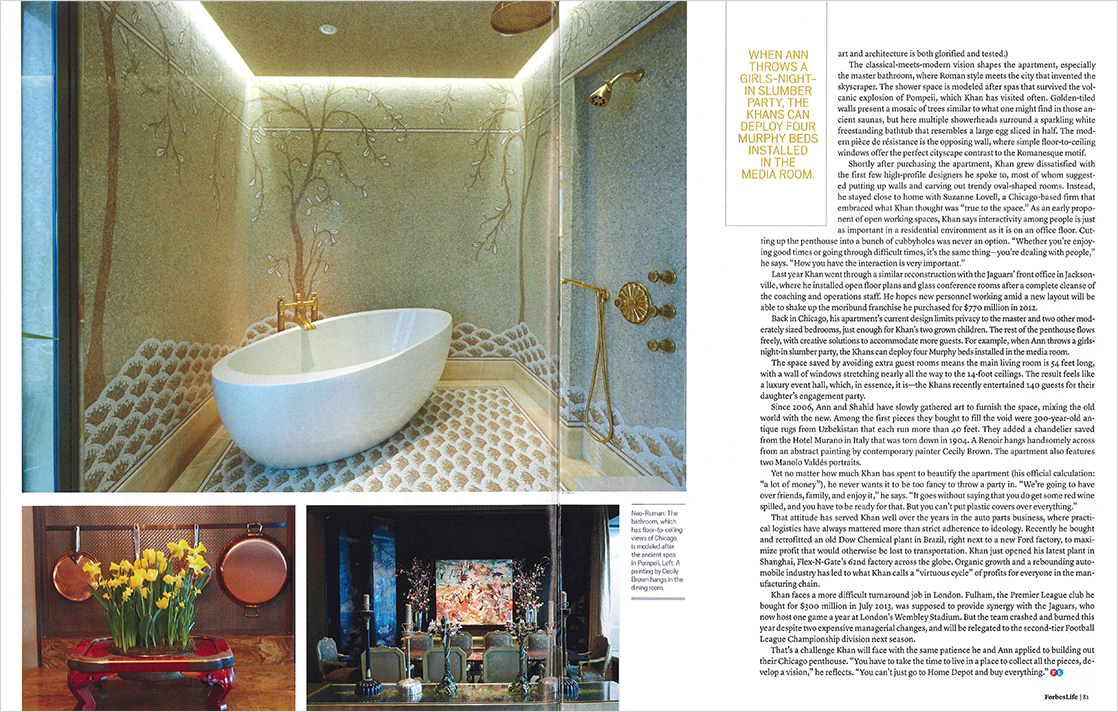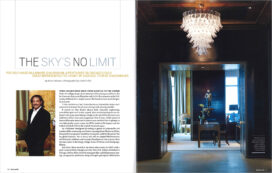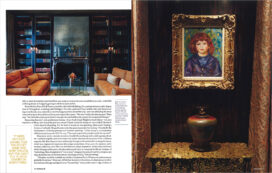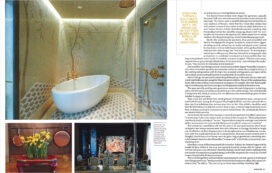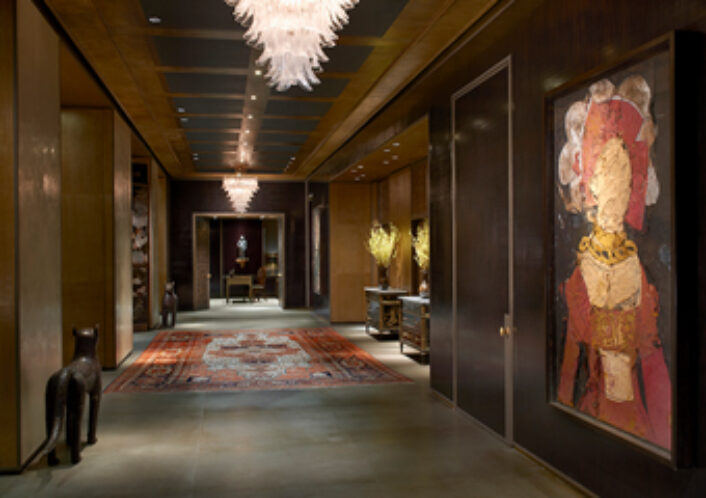Forbes Life – Cover Story July 2014
The Sky’s No Limit
For self-made billionaire Shahid Khan, a penthouse in Chicago’s Gold Coast represented the height of success. Then he aimed higher.
When Shahid Khan flew from Pakistan to the United States for college at age 16, he dreamed of becoming an architect. But he threw out that career blueprint early in his first semester at the University of Illinois for a simple reason: He found out how much the profession paid.
“I love architecture, but I learned early on that architects just don’t make a lot of money,” the 63-year-old says with a hearty chuckle.
It turned out that Khan’s chosen field, industrial engineering, served him quite well in that regard. After revolutionizing the car industry with a one-piece bumper design in the late 1970s, he went on to build $4.4 billion auto parts juggernaut Flex-N-Gate , which powered him to billionaire status and in recent years enabled him to splurge on two high-profile sports teams: the NFL’s Jacksonville Jaguars and the Fulham Football Club in the English Premier League.
As a Pakistani immigrant jet-setting to games in Jacksonville and London while overseeing new factory openings from Mexico to China, Khan (with his signature handlebar mustache) could be the poster boy for global business. But at heart, he’s still an adopted Midwesterner, with his main residence and company headquarters just minutes from his alma mater in the sleepy college towns of Urbana and Champaign, Illinois.
And when Khan wanted to lay down urban roots, he didn’t seek a pied-à-terre in Paris, Shanghai or even New York. Rather, he looked to Chicago. Before either football team gave him a global presence, buying an expansive penthouse along Chicago’s prestigious Magnificent Mile in 2006 showed the world that Khan was ready to conduct business on a billionaire scale–and fulfill a lifelong dream of design he gave up on all those years earlier.
From the 61st floor of Park Tower, one of the city’s tallest buildings, his apartment boasts a 360-degree view of Chicagoland, including Lake Michigan. The vista captivated Khan and his wife (and former college sweetheart), Ann, when they were touring properties around the city–and was ultimately the main reason they spent $8.3 million on the 9,000-square-foot space. “We were looking for about a year,” Khan says, “but when this came up we knew it was special and would really capture the essence of Chicago.”
Respecting the city’s rich architectural history–from Frank Lloyd Wright to Frank Gehry–was also important to Khan, who found the previous owner’s bleak modernist design of unvarnished bleached-white drywall off-putting. For the kind of money he was spending, Khan wasn’t buying a fortress of solitude. His goal was to make the space impressive but inviting–friendly for the dual purpose of family getaways and business meetings. “Urban living is an intersection of business and personal life,” he says. “You need a space that people want to be a part of.”
Khan drew on his extensive travels to furnish the penthouse with a rich tapestry of color–a palette of golds, reds and browns that evoke a luscious throne room fit for a Chinese emperor. But those hues are used judiciously throughout the minimalist rectangular layout, which was engineered to preserve the unique proportions. Khan, ever the amateur architectural enthusiast, cites Mies van der Rohe as a major inspiration. As the influential head of the Chicago architecture school at what would later be renamed the Illinois Institute of Technology, Mies championed a “less is more” design philosophy of steel-framed glass and once described one of his more famous buildings as being “almost nothing.”
“This place would be woefully out of place in Jacksonville, in Urbana, everywhere except probably Barcelona,” Khan says. (With four factories in Barcelona, he draws many similarities between Chicago and Spain’s own “Second City,” where at the water’s edge a history of art and architecture is both glorified and tested.)
The classical-meets-modern vision shapes the apartment, especially the master bathroom, where Roman style meets the city that invented the skyscraper. The shower space is modeled after spas that survived the volcanic explosion of Pompeii, which Khan has visited often. Golden-tiled walls present a mosaic of trees similar to what one might find in those ancient saunas, but here multiple showerheads surround a sparkling white freestanding bathtub that resembles a large egg sliced in half. The modern pièce de résistance is the opposing wall, where simple floor-to-ceiling windows offer the perfect cityscape contrast to the Romanesque motif.
Shortly after purchasing the apartment, Khan grew dissatisfied with the first few high-profile designers he spoke to, most of whom suggested putting up walls and carving out trendy oval-shaped rooms. Instead, he stayed close to home with Suzanne Lovell, a Chicago-based firm that embraced what Khan thought was “true to the space.” As an early proponent of open working spaces, Khan says interactivity among people is just as important in a residential environment as it is on an office floor. Cutting up the penthouse into a bunch of cubbyholes was never an option. “Whether you’re enjoying good times or going through difficult times, it’s the same thing–you’re dealing with people,” he says. “How you have the interaction is very important.”
Last year Khan went through a similar reconstruction with the Jaguars’ front office in Jacksonville, where he installed open floor plans and glass conference rooms after a complete cleanse of the coaching and operations staff. He hopes new personnel working amid a new layout will be able to shake up the moribund franchise he purchased for $770 million in 2012.
Back in Chicago, his apartment’s current design limits privacy to the master and two other moderately sized bedrooms, just enough for Khan’s two grown children. The rest of the penthouse flows freely, with creative solutions to accommodate more guests. For example, when Ann throws a girls-night-in slumber party, the Khans can deploy four Murphy beds installed in the media room.
The space saved by avoiding extra guest rooms means the main living room is 54 feet long, with a wall of windows stretching nearly all the way to the 14-foot ceilings. The result feels like a luxury event hall, which, in essence, it is–the Khans recently entertained 140 guests for their daughter’s engagement party.
Since 2006, Ann and Shahid have slowly gathered art to furnish the space, mixing the old world with the new. Among the first pieces they bought to fill the void were 300-year-old antique rugs from Uzbekistan that each run more than 40 feet. They added a chandelier saved from the Hotel Murano in Italy that was torn down in 1904. A Renoir hangs handsomely across from an abstract painting by contemporary painter Cecily Brown. The apartment also features two Manolo Valdés portraits.
Yet no matter how much Khan has spent to beautify the apartment (his official calculation: “a lot of money”), he never wants it to be too fancy to throw a party in. “We’re going to have over friends, family, and enjoy it,” he says. “It goes without saying that you do get some red wine spilled, and you have to be ready for that. But you can’t put plastic covers over everything.”
That attitude has served Khan well over the years in the auto parts business, where practical logistics have always mattered more than strict adherence to ideology. Recently he bought and retrofitted an old Dow Chemical plant in Brazil, right next to a new Ford factory, to maximize profit that would otherwise be lost to transportation. Khan just opened his latest plant in Shanghai, Flex-N-Gate’s 62nd factory across the globe. Organic growth and a rebounding automobile industry has led to what Khan calls a “virtuous cycle” of profits for everyone in the manufacturing chain.
Khan faces a more difficult turnaround job in London. Fulham, the Premier League club he bought for $300 million in July 2013, was supposed to provide synergy with the Jaguars, who now host one game a year at London’s Wembley Stadium. But the team crashed and burned this year despite two expensive managerial changes, and will be relegated to the second-tier Football League Championship division next season.
That’s a challenge Khan will face with the same patience he and Ann applied to building out their Chicago penthouse. “You have to take the time to live in a place to collect all the pieces, develop a vision,” he reflects. “You can’t just go to Home Depot and buy everything.”
By Brian Solomon
Photographed by David Yellen
